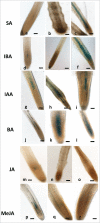SlWRKY45, nematode-responsive tomato WRKY gene, enhances susceptibility to the root knot nematode; M. javanica infection
- PMID: 29271721
- PMCID: PMC5792125
- DOI: 10.1080/15592324.2017.1356530
SlWRKY45, nematode-responsive tomato WRKY gene, enhances susceptibility to the root knot nematode; M. javanica infection
Abstract
The fluctuation of tomato's WRKY defense regulators during infection by the root knot nematode Meloidogyne javanica was analyzed: and the spatial and temporal expression of SlWRKY45 was studied in depth with regard to its response to nematode infection, phytohormones, and wounding. Expression of WRKY45 increased substantially within 5 d upon infection and continued through feeding-site development and gall maturation. Histological analysis of nematode feeding sites indicated that WRKY45 was highly expressed within the feeding cells and associated vascular parenchyma cells. Responses of SlWRKY45 promoters to several phytohormones showed that WRKY45 was highly induced by specific phytohormones, including cytokinin, auxin, and the defense-signaling molecule salicylic acid (SA), but not by the jasmonates. Overexpressing tomato lines were generated, and infection tests showed that, significantly, roots over-expressing SlWRKY45 contained substantially increased number of females, indicating that WRKY45 overexpression supported faster nematode development. qRT-PCR tests have shown roots overexpressing WRKY45 suppressed the jasmonic acid and salicylic acid marker genes, proteinase inhibitor (PI), and pathogenesis related protein (PR1), respectively, and also the cytokinin response factors CRF1 and CRF6. Overall, this study indicated SlWRKY45 to be a potential transcription factor whose manipulation by the invading nematode might be critical for coordination of hormone signals supporting favorable condition for nematode development in root tissue.
Keywords: Basal resistance; Meloidogyne javanica; WRKY transcription factor; innate immunity; phytohormones; plant defense signaling; root susceptibility.
Figures







References
-
- de Almeida Engler J, Engler G, Gheysen G. Unravelling the plant cell cycle in nematode induced feeding sites In: Jones J, Gheysen G, Fenoll C, eds. Genomics and Molecular Genetics of Plant-Nematode Interactions: Dordrecht: Springer Science+Business Media, 2011:349–368.
-
- Portillo M, Cabrera J, Lindsey K, Topping J, Andres MF, Emiliozzi M, Oliveros JC, García-Casado G, Solano R, Koltai H, et al.. Distinct and conserved transcriptomic changes during nematode-induced giant cell development in tomato compared with Arabidopsis: a functional role for gene repression. New Phytol. 2013;197:1276–1290. doi:10.1111/nph.12121. - DOI - PubMed
MeSH terms
Substances
LinkOut - more resources
Full Text Sources
Other Literature Sources
Research Materials
Miscellaneous
